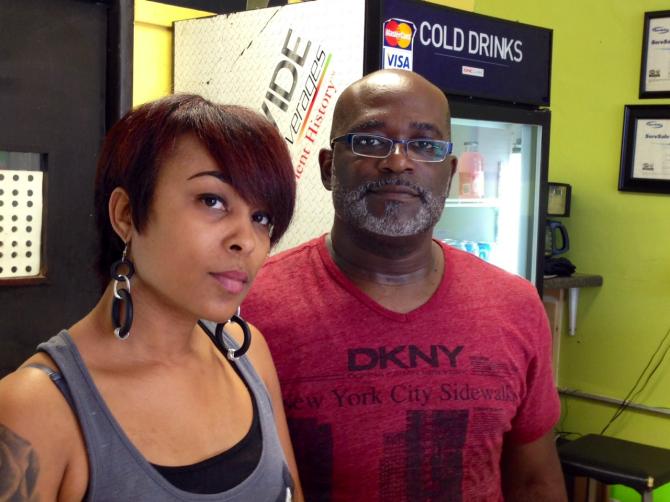By: Lynette Holloway

Friday, Aug. 8, was a big day for Kizzie and Charles Davis. It was the day they opened Ferguson Burger Bar & More on West Florissant Avenue for the first time after taking it over from the previous owner, they told The Root Monday.
But the next day, they were saddened to learn that Michael Brown was gunned down by a police officer, and within hours the streets were catching fire as angry protesters rolled out to call for justice over the shooting. The Davises’ business has closed early nearly every day since the shooting, and they worry about its future, but they are keeping faith. And while saddened by Brown’s death, they see one silver lining. There is new attention on a long-simmering issue in the black community: police brutality and the use of excessive force.
“It’s bittersweet,” Kizzie Davis, 35, of Ferguson, told The Root, taking a break from the lunchtime rush, serving up burgers, catfish and jack-tail dinners and Philly-cheesesteak sandwiches. “Brown’s unfortunate death has turned attention to an important issue of the black community’s relationship with the police. We hope it brings about lasting change.“
Not far from where the 18-year-old was shot by Ferguson Police Officer Darren Wilson, new Ferguson resident Jesse Burns worked quickly to trim his lawn on Monday afternoon before nightfall. He did not mince words when asked about life in Ferguson. “Terrible,” Burns, 40, told The Root with a nervous laugh during an interview just a stone’s throw from his tidy three-bedroom house off Canfield Drive, which he moved into about three weeks ago. “The police or whatever won’t let me come home if it’s too late [between 3 and 5 p.m.]. The streets are blocked off.”
In fact, Burns, who came to Ferguson from another St. Louis suburb and works for UPS Trucking, said the roadblocks are so bad that he had to sleep at his girlfriend’s house in a different community Sunday night after work because the roads were closed to vehicle traffic. He was off Monday, so he used the time to inspect his home and do a little lawn maintenance, he said.
Schools have shut down because of fear of violence around children walking to or from school, prompting families to make alternate child-care plans or simply stay home from work. Gloria Vann, 65, a retired public school administrative assistant who lives in Ferguson, stepped in to help out by taking care of her great-grandsons, 9 and 12, who were off from school. She declined to give their names.
“I’m happy to be out of school,” the 12-year-old told The Root, but “I’m not happy about the shooting.”
Vann and the boys stood along West Florissant Avenue, a busy commercial strip in Ferguson, observing the scene a little after noon on Monday. “I brought them out so they could see why they can’t go to school today,” she said. “When I get back home, I will review the things we saw. They had a chance to meet Jesse Jackson and took pictures with him.”
The Revs. Jackson and Al Sharpton have made appearances in Ferguson, calling for peace and calm. But the protests continue, taking on a life of their own, marked alternately by violent outbursts and acts of civil disobedience played out on West Florissant Avenue. And after nearly a week of violent clashes between police and protesters, Missouri Gov. Jay Nixon announced early Monday that the National Guard would patrol the streets, increasing anger and resentment among some residents. U.S. Attorney General Eric Holder plans to travel to Missouri amid a civil rights investigation into Brown’s shooting, President Obama announced during a news conference Monday.
Indeed, Ferguson at night almost rivals televised news images of some conflicts in the Middle East. Sirens wail against the backdrop of chanting protesters and bottles crashing on the cement, and ribbons of flashing blue and red police lights illuminate the dark sky as hulking armored tanks block off major intersections.
Scores of people, young and old, line both sides of West Florissant Avenue. Some chant, others thrust their hands in the air as if under arrest, while others simply stand by taking in the scene, snapping pictures. The media scrum generates the attention of those who want justice for Brown, as well as some fame seekers and outside agitators, residents, including Burns, have told The Root.
Snaking roadblocks, with scads of officers standing sentinel, aren’t the only problem, according to Burns. He says that noise is generated by police helicopters that begin circling overhead with spotlights at nightfall and continue until daybreak. “I can’t get any sleep around here,” he said. “I know I’m right here in the middle of it, and I can’t expect for it to be quiet, but some nights I just don’t stay over here.”
As for the violence, residents hope it will ratchet down soon, especially with Holder planning to make an appearance in the city.
“I believe it’s the people that are not of this area that’s creating all of the havoc,” Vann said. “And the police are instigating this. Why do they need to throw fire or gas bombs at these youths? Why? That’s not the solution, and bringing in the National Guard is not the solution, either. They need to sit and listen to what the people have to say. That’s where they need to start.”
Lynette Holloway is a contributing editor at The Root. The Chicago-based writer is a former New York Times reporter and associate editor for Ebony magazine.















